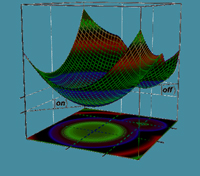Projekto įranga
Supercomputer
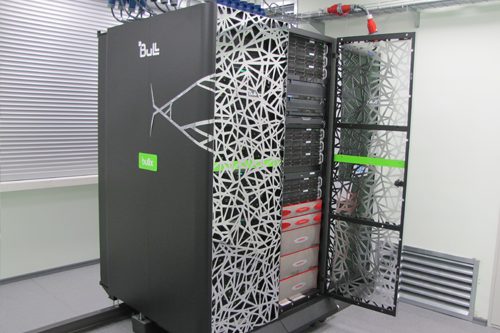
Sistemoje esami superkompiuteriniai resursai:
Superklasteris "Fizika"
1032 Intel x86_64 skaičiavimo branduoliai paskirstyti 87 skaičiavimo mazguose, kur 84 mazgai turi po 12 branduolių ir 3 grafiniai mazgai – po 8 branduolius. Pastaruoiuose yra po 2 CUDA grafinius procesorius (viso sistemoje 6 CUDA GPU). Klasteris valdo beveik 4 terabaitus atminties (RAM). 84 mazgai turi po 48 GB ir 3 grafiniai mazgai po 24 GB atminties. Vartotojai prie sistemos prieina per PBS Pro užduočių valdymo sistemą.
Rmax (visos sistemos): 9.537e+03 Gflops
1 SMP Rmax (vieno mazgo): 1.155e+02 Gflops
Superkompiuteris "Altix UV 1000"
Vienas kompiuteris su 120 Intel x86_64 skaičiavimo branduoliais ir beveik 2.5 TB RAM.
Rmax: 1.160e+03 Gflops
Streak camera
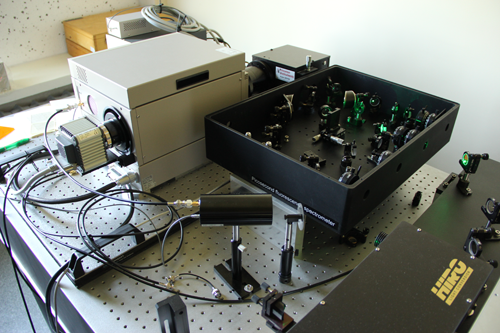
Streak camera is a device used to measure ultra-fast fluorescence. Several of the many advantages against other fluorescence measuring systems is that streak camera can register the entire data-set in very short time and it has very high time resolution – up to 0,2 ps. The principle of operation of the camera is similar to analog oscilloscope. Inside the device light is converted into stream of electrons, which is then converted back to light. The main concept of the camera is to bend the trajectory of the electrons with a varying electric field, which increases over time. Thus, the last electrons which arrive at the camera get bent the most. Since only one coordinate of the camera is used for time resolution (electron trajectory deviation), the other coordinate can be used to get spectral information. This allows gathering all the spectra with extremely good time resolution in one sweep. Streak camera is extremely useful if the sample is degrading fast or if we need to measure only the start of fluorescence decay (50-200 ps).
Our system uses 3W 1030nm "Pharos" as the main oscilator and "Hiro" harmonics genereator to produce laser pulses of ~80ps and 1030nm, 515nm, 343nm or 257nm. Frequency of the main oscilator (76MHz) can be reduced to 10kHz using Pockels cell.
Fluorescence lifetime spectrometer Edinburgh Instruments FL920
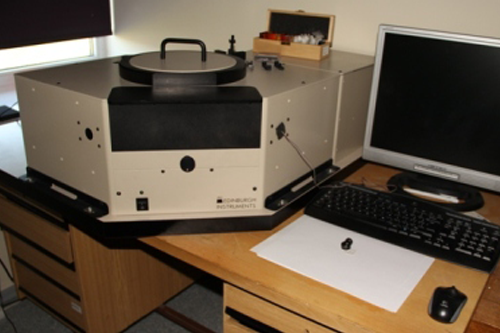
The FLS920-t is a modular, computer controlled fluorescence lifetime spectrometer.
Based on an L – geometry hardware configuration, the FLS920-t utilises the technique of Time Correlated Single Photon Counting (TCSPC) to measure time resolved luminescence spectra and luminescence lifetimes spanning the range from 100picoseconds to 10microseconds, with the accuracy and the resolution that only the technique of TCSPC can offer.
Features Include:
- Fluorescence lifetimes from 100picoseconds to 10microseconds
- High dynamic range and temporal resolution
- Time Correlated Single Photon Counting operation
- PC plug-in card for TCSPC
- Fully computer controlled through Windows (XP and VISTA 32 bit) software
- Full data reconvolution using a non-linear least square fitting routine
Single molecule spectrometer
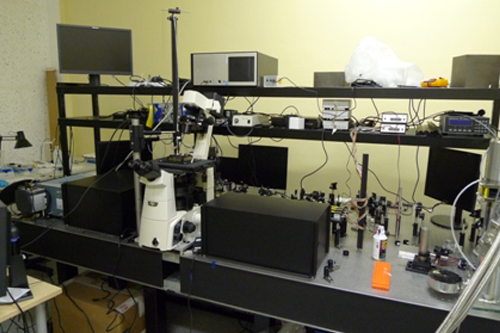
Single-molecule fluorescence spectrometer is for detecting fluorescence spectral dynamics from individual molecules immobilized on a surface or freely diffusing in solution. The setup can be operated in two excitation-detection configurations:
-
By exciting a wide sample field in total internal reflection (TIR) mode and detecting fluorescence signal from a number of individual molecules in parallel. Fluorescence image is split into two spectral components which allows observation of FRET in the donor-acceptor dye pair. The main advantage of this detection mode – the possibility of observation of a large number of molecules in parallel. The temporal resolution is limited, however, to approximately a video rate.
-
By exciting individual molecules in confocal mode and monitoring fluorescence from separate molecules one at a time. In this mode it is possible to acquire full fluorescence spectra. Temporal resolution for spectral acquisition is a few milliseconds, whereas if opting for the detection of only two spectral components, temporal resolution is up to a few tens of nanoseconds.
Moreover, in confocal mode it is possible to collect fluorescence bursts from molecules diffusing freely in solution. This way vast data statistics are collected relatively fast. By analysing such data with correlation analysis, it is possible to determine, for example, the efficiency of the excitation energy transfer inside the molecule of interest.

